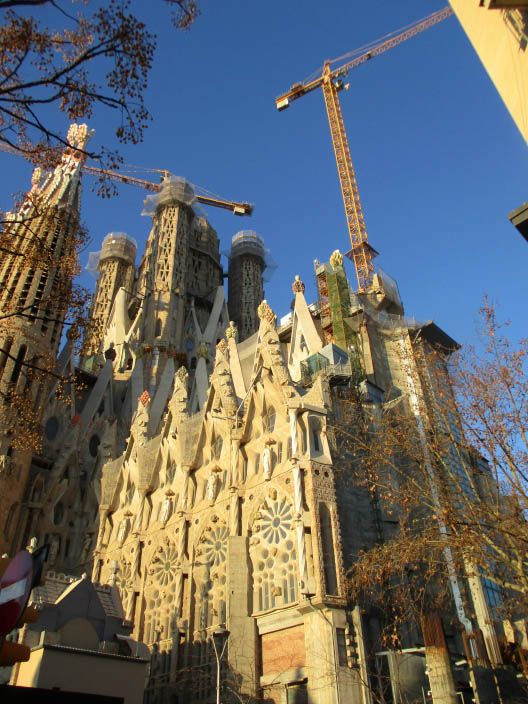A major religious asset of the city of Barcelona faces new delays, but maybe that’s not so bad.
by Gail Dallas Hook

Because of the pandemic, construction has halted on Barcelona’s La Sagrada Familia, the landmark church that has been under construction for nearly 140 years.
Photo by Gail Dallas Hook
Until last March, Barcelona’s masterpiece of religious architecture, La Sagrada Familia, was on track to be completed by 2026, a century after the death of its architect, Antoni Gaudí. Today, the basilica is closed and construction work halted, due to the Covid-19 pandemic. Spain has been locked down since March 14, with residents leaving home only for essential work, groceries, or medical reasons. The board of Sagrada Familia has set no date for reopening, although virtual visits are available online.
Formally named Basílica i Temple Expiatori de la Sagrada Família, the basilica was originally conceived in 1875 as a temple to contain the House of Nazareth from the Sanctuary of Loreto in Italy. Gaudí was awarded the post of senior architect in May 1884. His inspiration for La Sagrada Familia came from the Gothic Revival design of the original architect, the diocesan architect Francesc de Paula del Villar I Lozano. But until his death in 1926, Gaudí persisted in his own expressionist style and focused on parabolic forms for the temple. The current plan for completion of the building uses 3D printing and modeling technology, ultra-precise resin mock-ups, and fast-moving CNC (computer numeric control) cutters working from digital patterns to achieve the design, according to Architect magazine.
How tall will it be? Gaudí specified that the work of man should not compete with nor surpass God’s work; therefore, it should not compete in height with the highest natural ground in Barcelona, Mount Montjuic. This suggests “a multiple of the basic module of 75 meters as the measure used for the ground plan and the minimum height of the building,” according to the basilica’s architects.
When I visited Sagrada Familia in January, the site was marked by construction dust, noisy cranes, towers of steel reinforcing bars, and long lines of waiting tourists with tickets in hand (starting at €46). The basilica was in use for religious services and tourism even as construction continued, and many visitors came just to watch the upper facades and towers rise. Cynically, Manuel Vicent, a columnist for El País (Madrid), observed that the only saving grace of the church in its current state, “…was the fact that it was unfinished…when its walls are finally enclosed, there will be no one inside but…tourists.”
A few years ago, the green spaces around the building began to be absorbed by new buildings and streets as part of city planning projects, and the space once allotted for a grand stairway from the Glory façade to Avenida Diagonal is now filled with residential flats and cafes. Hannah Strange wrote in The Guardian (July 16, 2017) that some city leaders did not see the completion of Sagrada Familia as a priority and described the building as “an enormous farce that we’ve dragged out for a long time,” while local residents and shop owners point to anti-Church attitudes and the ongoing crackdown of the government on mass tourism.
The government may have a change of heart. Last year alone the basilica attracted over three million visitors, but the Covid-19 pandemic has all but ended tourism this year—a huge toll on the city that also highlights the importance of La Sagrada Familia for Barcelona.
AUTHOR NOTE
Gail Dallas Hook is an historian and architectural historian. She travels in the Mediterranean and writes about Mediterranean history, culture, and religious architecture.
